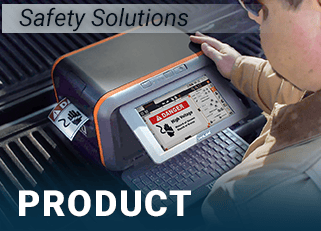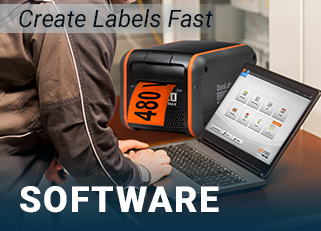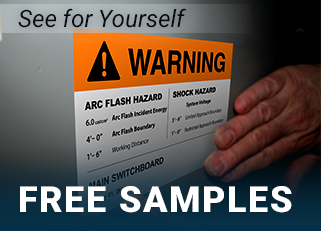Fault Current Calculations
03
February,
2023
4 MINUTE READ

A fault current is an unintended, uncontrolled, high current flow through an electrical system. Fault currents are caused by very low impedance short circuits. These may be shorts to ground or across phases. The resulting high current flow can result in overheating of equipment and conductors, excesses forces, and at times even serious arcs, blasts, and explosions. Causes of faults include things such as lightning strikes, animals, dirt and debris, dropped tools, corrosion, and human error.
Fault current calculations are based on Ohm's Law in which the current (I) equals the voltage (V) divided by the resistance (R). The formula is I = V/R. When there is a short circuit the resistance becomes very small, and that means the current becomes very large.
If the resistance was zero, then the calculated fault current would go to infinity. However, even copper wire has some resistance; it is not a perfect conductor. Determining the fault current involves knowing the total resistance from the power source to the location of the fault.
Fault Current Calculations Are Required
Knowing the available fault current is important when selecting protection devices, however it is also required by code. The National Electric Code (NEC) 110.24(A) states:
"Service equipment in other than dwelling units shall be legibly marked in the field with the maximum available fault current. The field marking(s) shall include the date the fault current calculation was performed and be of sufficient durability to withstand the environment involved."
This means there must be field installed labels on electrical equipment, such as service entrance equipment, that gives the available short-circuit fault current. This allows the Short Circuit Current Rating (SCCR) of the equipment to be easily compared with the maximum available fault current.
Any time there is a change in equipment the fault current calculation must be redone. This is specified in NEC 110.24(B):
"When modifications to the electrical installation occur that affect the maximum available fault current at the service, the maximum available fault current shall be verified or recalculated as necessary to ensure the service equipment ratings are sufficient for the maximum available fault current at the line terminals of the equipment. The required field marking(s) in 110.24(A) shall be adjusted to reflect the new level of maximum available fault current."
Types of Faults
In an electrical system there are several types of possible faults:
- A short circuit that results in the current bypassing the normal load.
- A "ground fault" in which current flows into the ground.
- In three-phase systems there may be a short between one or more phases. This type of fault typically creates the highest fault currents.
The fourth type of fault, an open-circuit fault, does not generate a short-circuit current. An open-fault results from the current being unintentionally interrupted.
Protective systems need to prevent equipment damage and protect people in all of the above situations. That means fault current calculations must be done so that the appropriate protective devices can be selected.
Bolted Faults vs. Arc Faults
An electrical fault can either be a bolted fault or an arc fault.
In a bolted fault there is a solid connection. This allows the fault current to flow through a conductor. This type of fault might happen when an installer connects to a power source to ground instead of to the point where it should be connected. When the power is switched on there will be an immediate bolted fault that trips the protective device. Because the current flow was contained, the damage is typically limited. However, a bolted fault creates the highest fault currents.
An arc fault results when there is not a solid connection, but conductors come close enough such that current jumps across the gap creating an arc. The initial arc ionizes the air creating a plasma that allows the current flow to rapidly increase and be sustained, resulting in an arc flash or arc blast. When an arc flash is possible then fault current calculations must be done to determine safe protection boundaries and required PPE, as well as to provide the information needed for arc flash labels that must be installed in addition to the required NEC 110.24 fault current labels.
Three Phase Faults
IEC 60909 "Short Circuit Currents in Three-Phase Systems" gives the accepted calculation method for three-phase fault currents.
A fault in a three-phase system can either be symmetrical (balanced) or unsymmetrical (unbalanced). In a symmetrical fault all three phases are equally affected. However, this rarely happens. Most three phase faults are unsymmetrical, and that makes doing the fault current calculation more difficult.
Sources of Content
Before a fault current calculation can be performed, all of the possible sources of current must be identified. This can include some sources of current that may not have been considered. There are four possible sources of short-circuit fault current:
- On-site electric generators: These are close and the fault current is only limited by the impedance of the generator itself and the electric circuit.
- Synchronous motors: a synchronous motor is an AC motor in which the speed of the motor is proportional to the frequency of the electric power. When the power fails, as will happen if there is a short-circuit, the inertia of the mechanical load on the motor will continue rotating the motor. The motor will then act as a generator supplying current, and this will contribute to the total current flowing to the fault.
- Induction Motors: this type of motor will also become a generator should there be a short-circuit fault somewhere else in the system. However, the fault current generated by an induction motor will only last for a few cycles. The current will be approximately equal to the locked-rotor starting current of the motor.
- Electric utility system: most of the fault current typically comes from the electric utility. The level of the short circuit current will depend on:
- the transformer secondary voltage rating and impedance
- the impedance of the generators
- the impedance of the circuit from the transformer to the short.
To simplify the fault current calculation it is assumed that all electrical generators in the system are in phase, and that they are operating at the nominal system voltage.
Bolted Three - Phase Condition
A short circuit study is conducted so that the fault current can be calculated. This normally involves looking at the worst case scenario, which is the bolted three-phase fault condition. Based on this situation other fault condition can be approximated.
The fault current contribution from motors in the system is important. In many cases motors can contribute four to six times there normal full load current. Even if the current is for a very short duration, it is critical that it be included in the fault current calculation.
When an arc flash study is being done, the fault current calculation should still be for the highest bolted three-phase short circuit current.
Fault Current Labeling
Once the fault current has been calculated, labels made giving the available short circuit fault current, should be applied to the equipment. If an arc flash label is required, it should also be printed and applied in the appropriate location. Each label requires custom information that comes from the fault current calculation.
Take the Next Step
Now that you have a basic understanding of the variables in arc flash calculations, download our free Arc Flash Energy Guide for detailed advice on how to implement a safety system in your facility. Download your free copy today!
RELATED RESOURCES

Arc Flash in Mining
Very little can happen in mining without electricity. From drilling equipment and powered shovels to fixed ...
Read
Arc Flash PPE
Personal Protective Equipment (PPE) is the last line of defense against injuries. When it comes to arc flash, ...
Read
NFPA 70E Arc Flash with OSHA Signs
What is NFPA 70E? NFPA 70E, or the NFPA's Standard for Electrical Safety in the Workplace, outlines specific ...
Read.png)


